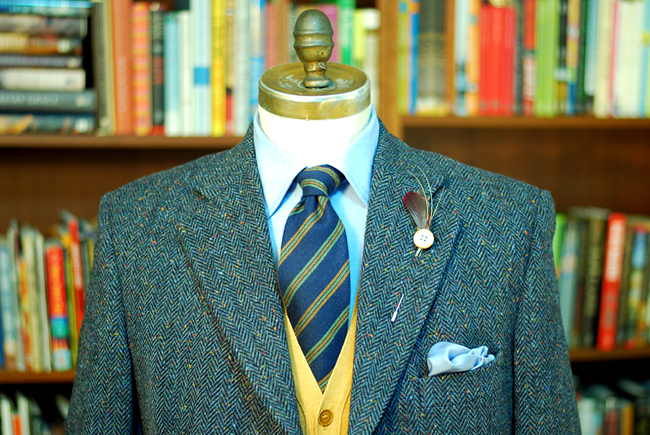When I first saw Hook and Furl lapel pins on the Gotstyle twitter feed, I fell in love. It wasn’t just that they reminded me of fishing flies (I love fishing) or the English countryside (I love Downton Abbey) or the feathers in some fedoras (I love hats). It’s that they were at once very alluring and very challenging, contemporary and classic. We live in an age of dandies and slobs, men who care a lot about how they dress and those that rail against what they see as artifice. These pins sing a Siren song to the former while pissing off the latter. And then there’s our fluid and complex understanding of masculinity that wonders: are these pins too feminine? Can an accessory even have a gender? All that in a little lapel pin.
But before I get carried away, the story of how these pins came to be.
John Jay is not a priest but was officiating a wedding last year when he saw something that stunned him. Not the wedding dress, not a drunk uncle. A guest at the reception was wearing a button and feather thing on his lapel and John was transfixed. He went up to the guy and asked what was it and could he buy it from him. Right there and then. The guest was Mark Abraham, a history professor at Ryerson University, and he had made the lapel pin that day. He didn’t have any to sell. In fact, he didn’t have any others. But Mark entertained John’s idea of making more and even, maybe, starting a company together to sell them.

A year later, John and Mark have made hundreds of these avian accessories and are selling them around Toronto and on etsy. They debated calling them “BRO-ches” but wisely stuck with “lapel pins.” John tells me the company name comes from the pins themselves: “hook” is the curled tip of a feather, while “furl” refers to the base. The buttons used are from “a big box” they happen to have on hand, while most of the feathers are dyed turkey. Occasionally they use unique, unusual found feathers.

I have to admit that once I was actually face to face with these pins, I was a little daunted by their dazzle. They are gorgeous pieces, but when I held up the more colourful ones to my lapel, they just didn’t suit me. I ended up going for this more subdued version which, while still a statement, is muted. That said, it got me thinking about the meanings behind accessories and dress.
The return we are seeing to classic men’s style is exciting because it brings with it the opportunity for evolution. With the movement away from suits and ties in the 60s and 70s, classic elements like hats and accessories stagnated. They had always evolved and changed, if ever so subtly, through the first half of the 20th century, but once they were shelved, they languished. Now that some men are wearing these pieces again, they have come back to life.

But evolution is different than change for change’s sake. A lot of what is going on in contemporary menswear doesn’t work for me because it does not honour or respect the history of men’s style. You don’t simply make something new by adding a splash of colour to it, or introducing lots and lots of pockets.
Why I like Hook and Furl is that they’ve taken a time-honoured accessory and modernized it, but in a way that still looks classic. Partially, that’s because it evokes fishing flies and country hats. But it also takes us back to a time when men were more whimsical and flamboyant with their dress.
This is my grandfather in the late 1920s. He was a Portuguese rural labourer who also lived and worked for a time in the US. He had very little money and yet, when he had this photo taken, he managed to pull together a three-piece suit, a tie pin, a massive (MASSIVE) flower and an ostentatiously puffed pocket square. Of course he was not trying to be feminine. In fact, this shows that “masculinity” was not so strict as it is today, and that flowers and flamboyance were perhaps the epitome of manliness.
John Jay’s father also knew how to dress well and when to embrace flamboyance. He had that skill, lost to those of us born in the 70s onward, of how to dress appropriately for different occasions. And he tried to pass this knowledge to John. For instance, he expected his son, by the age of twelve, to know at least three different tie knots and how to properly tie a bow tie. But would he have worn the feather and button lapel pins his son is now making and selling?

John tells me that were his father still alive, he would like his lapel pins, but would save them for parties and other extra special occasions. As would, I like to think, my grandfather.
Hook and Furl lapel pins are available at Gotstyle, Gian Paolo Mazzotta, Model Citizen, Made You Look, Off the Cuff, Garrison Bespoke, Room 2046 and Labour of Love.






Leave a comment